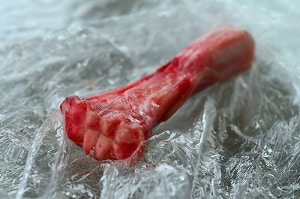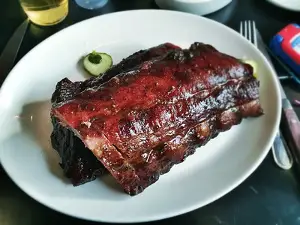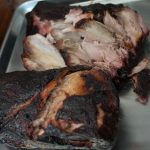Did you know that the average amount of lamb eaten by an American was just over a pound in 2020?
Which is a huge drop from the five pound average consumption which was seen in the 1960s?
And that this is peanuts when you think that the average for chicken per person is over 200 lbs.
Bearing that all in mind, it would seem that finding any lamb bones to buy might be an achievement in and of itself.
What are the most widely available cuts of lamb?
And a glance at some of the biggest grocery stores in the US shows that your choice of cuts of lamb that might contain some bone are very narrow.
I mean lamb chops are widely available but a leg, shank or rack of lamb?
Let me tell you that these are much harder to find on main street.
You might want to send out feelers to your local butcher…
Should my dog eat lamb bones? 4 considerations
Unfortunately, the answer to this question isn’t as simple as saying all lamb bones are safe for your dog or that all lamb bones are dangerous to dogs, as there are too many factors to consider.
I have narrowed it down to four important principles that you can use to help you sort the safe lamb bones from the dangerous ones.
And here goes.
First up, is the size of a bone.
And this is as a comparison to the size of your dog’s mouth…
Would it be possible for an aggressive chewer to swallow the bone whole, potentially choking them?
Size wise you want a dog to look at a bone and think “I need to gnaw that”…
Next up, is the shape.
And what I really mean is how sharp the edges are.
Sharp edges can cut a dog’s mouth, throat and beyond as the bit of bone is swallowed and starts its journey through a dog’s digestion system.
Which rules out all the bones that come with chops…
Thirdly, bones need to be raw.
Raw bones, strange as it is to say, have a softness or suppleness to them so that as a dog gnaws on them the pieces that come loose aren’t sharp.
Once a bone is cooked, they become much harder and more brittle.
When cooked bones are chewed, the pieces that come loose can be very sharp, which are dangerous.
Lastly, bones need to be weight bearing.
Weight bearing bones are physically bigger in size and they are denser and less brittle than non weight bearing bones.
To move away from lamb for the moment, think about the difference between a raw chicken wing and a raw chicken leg bone…
Lamb bones that are safe for your dog
So after moving through that checklist, what lamb bones would be considered safe?
Well the obvious one is a raw lamb leg bone because of its size and the fact that it is weight bearing.
And it needs to be raw so if you do buy a leg of lamb, extracting the bone is quite a lengthy process.
Alternatively, treat yourself and your dog and visit your local butchers to get a butterfly leg cut and ask to keep the bone.
Your only other option might be a shoulder bone.
But I’m not sure exactly how big these bones are or how widely available they might be?
What are the most dangerous lamb bones?
I think that I have already mentioned that bones that you find on different lamb chops are not suitable for dogs because of how sharp they can be
Other examples of lamb bones to avoid are the shank bones and the rib bones that you get on a rack of lamb.
Once again these bones tend to be sharp…
And whilst we are on the subject of sharp and troublesome lamb bones, in the next section I want to think about what you should do if your dog ate a lamb bone that he shouldn’t have..
What should I do if my dog ate a lamb bone?
I’m not saying that if your dog has swallowed part or all of a lamb bone that all hope is lost and that your dog is doomed because that just isn’t the case.
Plenty of dogs have narrow escapes whilst chewing bones and live to tell the tale or at least live to do exactly the same thing with a bone a few days later.
But as I have pointed out (again and again) swallowing too big a bit of bone or swallowing a razor sharp piece of bone probably will have a few nasty consequences.
If the bone is too big and your dog starts to choke then the symptoms are pretty obvious because your dog will be coughing and gagging in response.
Although there are things that you can try at home such as putting your fingers down your dog’s mouth, doing the dog heimlich maneuver or trying to induce vomiting all of these carry their own risks.
Your best bet would be to try and get your vet on the phone or if your dog has been struggling for a few minutes just rush him to the vets as fast as possible.
The other danger of your dog having eaten a sharp fragment of lamb bone is that it will graze or cut your dog’s throat, esophagus or another part of their digestive system as it makes its way through your dog’s body.
And you might only notice this if you see blood in your dog’s saliva or if you see it in their stool.
Is it dangerous to feed raw lamb meat to a dog?
Meaty bones that you get from your local butchers or meat markets have bits of well. meat, hanging off them.
Is raw lamb going to cause a dog any trouble?
Most likely, your dog will be fine eating the few bits of lamb that are holding onto the bone for dear life.
But there are risks that any raw meat might have some kind of bacteria hidden in its depths.
And for lamb that the bacteria includes salmonella, e coli and clostridium.
E coli is the bacteria that presents the biggest danger to dogs.
If a dog catches a virulent strain of e coli from eating raw lamb then it may cause a nasty bout of diarrhea.
And e coli is even more dangerous to puppies because their immune system is still strengthening.
And from talking about raw lamb in the next section I want to take a closer look at cooked lamb….
The safest way to feed cooked lamb bones to your dog?
Throughout this article one of the big themes is that dogs should only ever be given raw bones to chew on.
But it has occurred to me that there is a way that your dog can “eat” cooked lamb bones safely.
And is by making a lamb bone broth.
OK, if that sounds a little bit too Harry Potter for you then let me explain…
Bone broth is made by boiling the cooked bones of an animal in water and vinegar for hours- many recipes recommend cooking the broth for between 12 and 24 hours.
It takes this long for the bones to start to melt or disintegrate and release the huge amounts of nutrients that they contain.
These nutrients include calcium and magnesium from the bones and vitamin A from the marrow to mention just a few.
And once these nutrients are in the broth, they are very easy for a dog’s body to absorb them.
The benefits bone broth brings to dogs include helping to strengthen bones, fighting inflammation and aiding the digestive system.
Which is ironic if you think about the threat that sharp, spiky bones pose to the same system.
Here is a lovely recipe to follow at home.
As it isn’t a recipe specifically for dogs, don’t add the celery or onion!
And for my “last hurrah” about lamb bones, I want to briefly discuss, in terms of your dog’s teeth, if bones are their friends or their foes.
Lamb bones for dogs teeth: friend or foe?
Bones are teeth friendly because of their potential to help clean the teeth.
Raw bones clean a dog’s teeth and gums because the gnawing action places the hard surface of the bone up against the hard surface of the teeth and then friction cleans the surface of the teeth.
Next time, you give your dog a bone, watch them and look at the different positions in the mouth that they put the bone in.
They will switch the positioning from the left hand side of the mouth to the right hand side of the mouth and then they will gnaw on it with their front teeth.
It is clever stuff and apart from using a toothbrush it is the next best thing for teeth cleaning!
However, there is a darker side to the relationship between teeth and bones and that is because gnawing on the wrong sort of bone or gnawing on a bone for too long can break teeth, which is obviously very serious.
And it is this threat, along with the others that have been discussed in this article, which require us all to only give bones to our dogs when we are with them.
Because the consequences of anything going wrong are pretty serious.





